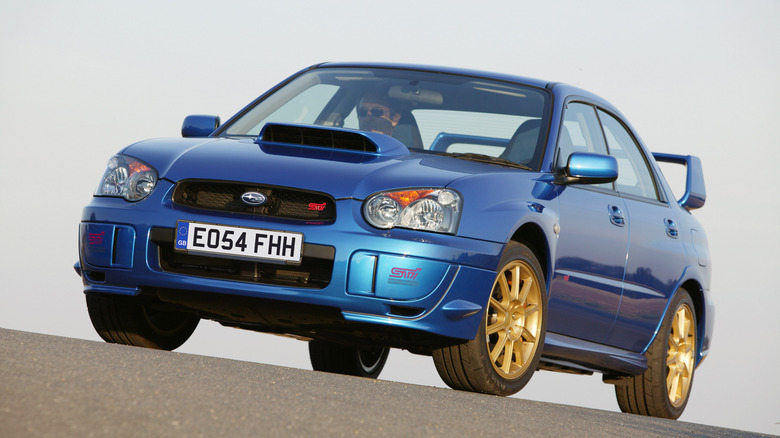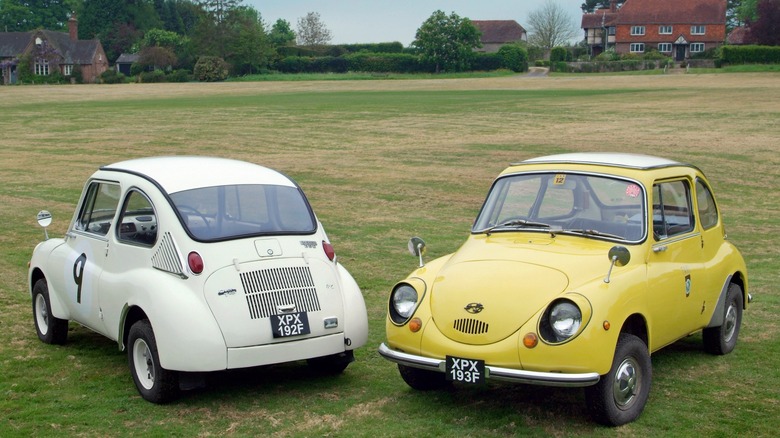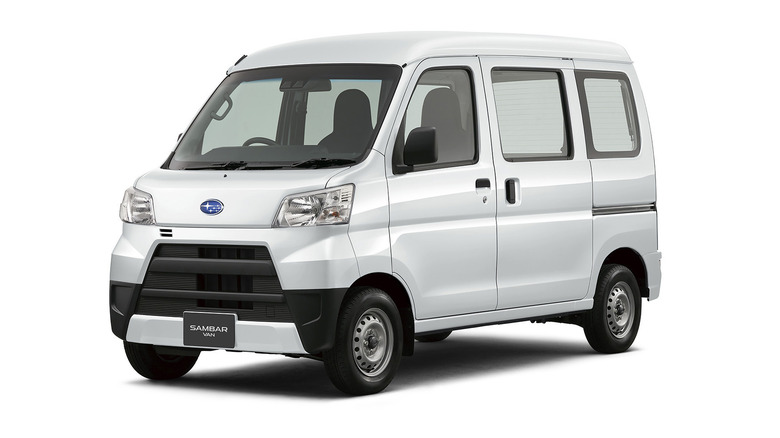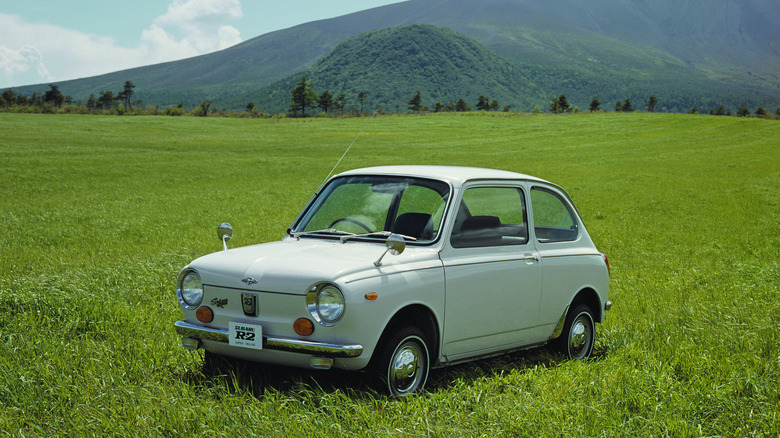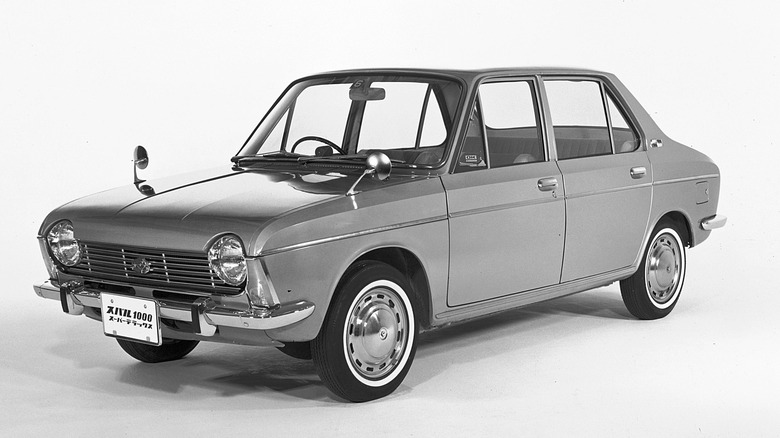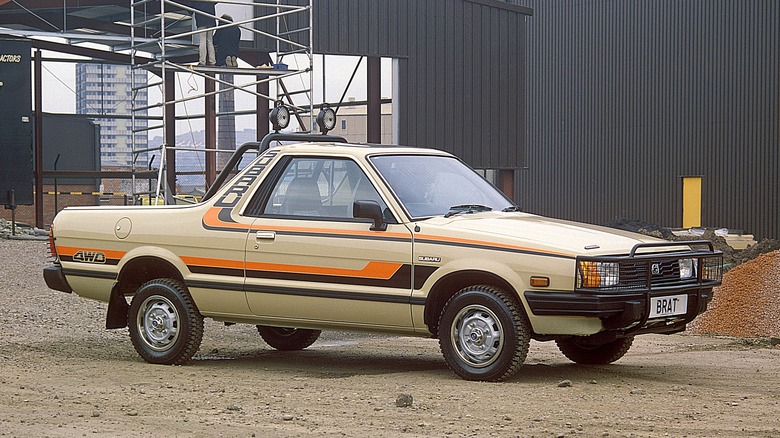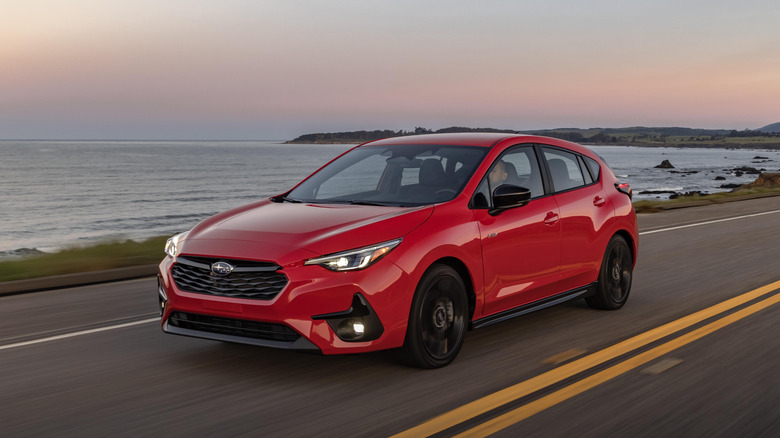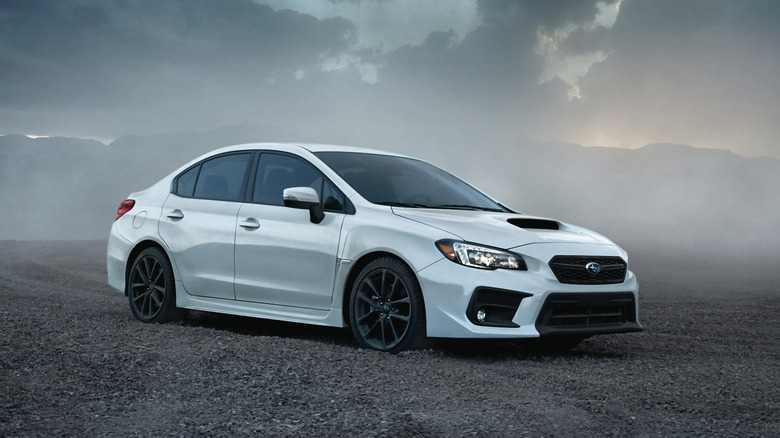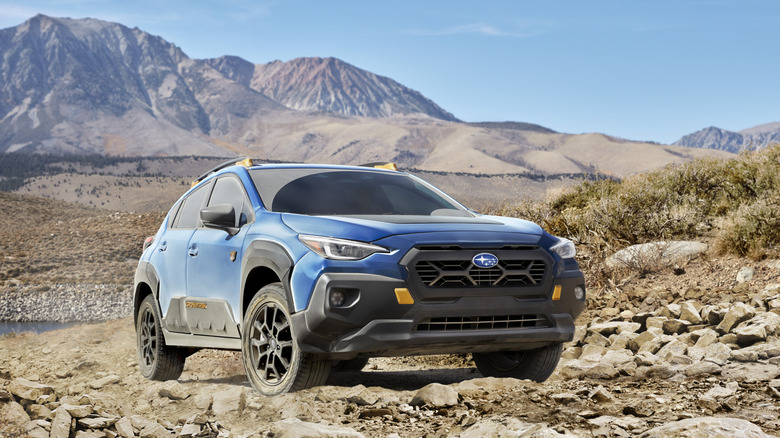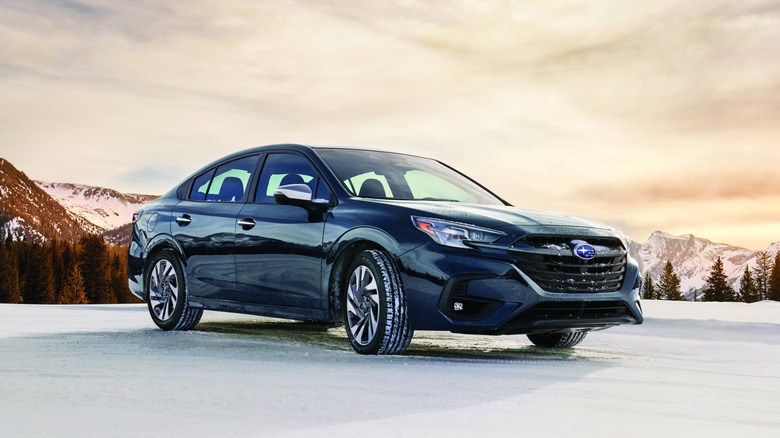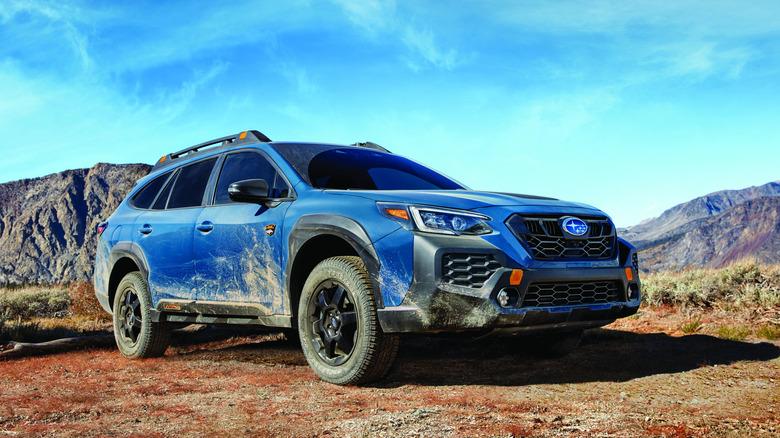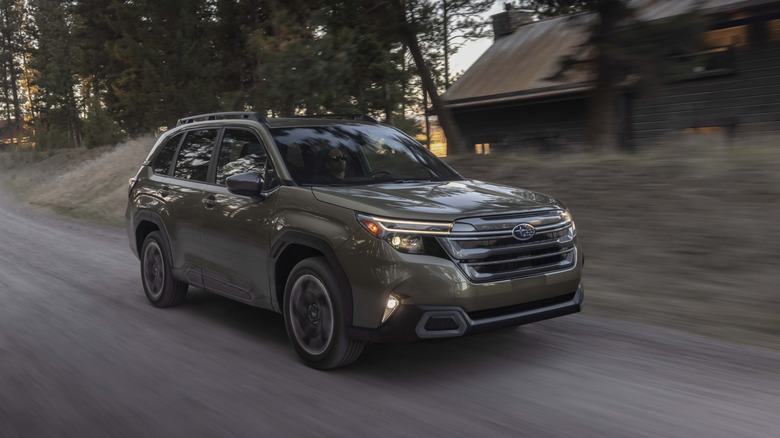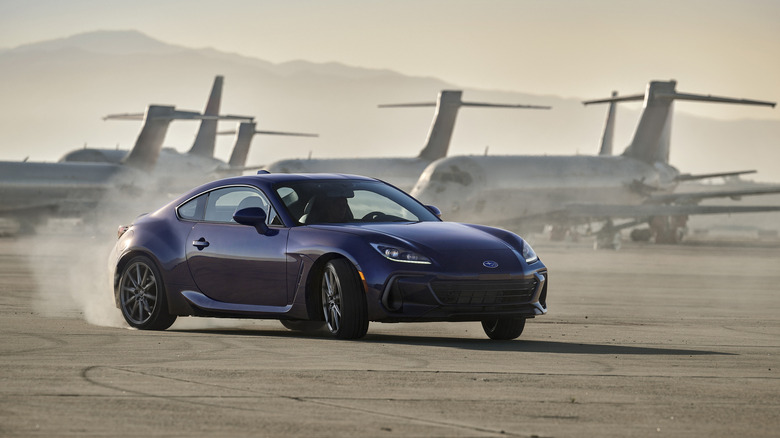12 Of The Most Successful Models In Subaru History
Standing out. This is perhaps the motto that has forever described Subaru as a brand. First, there's the company's unique approach of adding AWD and a boxer engine in every vehicle, which combine through engineering brilliance to create a unique driving experience. There's also the company's thirst to compete at the highest level and make high-performance machines that enthusiasts would crave.
However, there is more to Subaru's story, which now spans more than 70 years. From quirky machines that gained cult followings, to rally-winning icons and segment-expanding pioneers, let's take a look at the most successful Subaru vehicles ever produced. These cars made Subaru the automaker it is today, and made it one of the brands with the most loyal fanbases.
So, we won't be focusing only on sales numbers. Sure, they will play a role, but influence and legacy will be equally important. Some of the models listed here might not have sold very well, but they still showed a clear path forward for Subaru. With that settled, let's have an in-depth look at Subaru's most successful models in its history.
Subaru 360 (1958-1971)
After releasing several prototypes a few years prior, Subaru finally unveiled its first production car in 1958. Called the 360, this minicar was designed to motorize Japan's growing economy. Think of it as Subaru's take on the VW Beetle. In this case, everything was minimized.
The 360 had a tiny air-cooled 356cc two-cylinder engine in the back. Initially, it made only 16 hp and had a three-speed manual gearbox. However, power was increased later to 25 hp, and the transmission had four forward speeds. This combo could propel the microcar to 59 mph, which is not bad for the power on offer, and a consequence of the 360's comically low weight of 1,210 pounds. Interestingly, Subaru utilized a fiberglass roof and plastic rear windows not only to cut weight, but also make the 360 more affordable. Although it measured just under 10 feet long, the Subaru 360 could fit four passengers. The rear-hinged doors helped with ingress/egress, too.
Subaru captivated the Japanese public with the 360, thanks in no small part to the quirky, cartoonish looks. 400,000 examples were sold, which catapulted the company as one of Japan's biggest automakers. It was also Japan's first Kei car, which adds to its significance. Sure, you can also view it from another perspective, as the 360 is also considered Subaru's worst car, mainly due to poor safety. Still, this doesn't diminish its importance in Subaru's shoot to prominence.
Subaru Sambar (1961 to Present)
Three years after releasing the 360, Subaru introduced the Sambar truck. Based on the 360, the Sambar was aimed at the growing business sector in Japan and had a few advancements over other commercial vehicles. Namely, the lowest deck body and the roomiest cargo bed, despite the diminutive dimensions. The minitruck retained the same 356cc engine as the sedan, and weighed 1,180 pounds, giving it a 55 mph top speed.
The Sambar was a huge success for Subaru, so much so that an eighth-gen model still sells in Japan today. The latest model still belongs to the Kei car category and comes with a 650cc engine and a CVT. It's more capable than ever, but still keeps the affordable, yet practical mantra. It looks sharper, too, though its small size still gives it cute vibes.
More than that, though, the Sambar captured the imagination of fringe auto lovers. Subaru also offered it as a van throughout the generations, and one of its big selling points was the 4WD drivetrain. But it isn't only there to provide you with better snow traction — some models were even equipped with a low-range gear. Thus, off-road-capable Sambar trucks with knobby all-terrain tires are a common sight in Japan. So, somewhat unsurprisingly, Sambars are popular for mini-camper conversions, which can even bring you deep into the wilderness.
Subaru R-2 (1969-1972)
In 1969, Subaru launched its second Kei car aimed at the average Japanese car buyer. The R-2 looked more modern than the 360, with a mini-sedan design similar to its larger counterparts from Europe and the U.S. It offered more interior space, thanks to the wheelbase being 4.7 inches longer, with Subaru claiming it was comfortable for four people. Even so, the R-2 remained tiny, measuring 9.8 feet long and only 51 inches wide. Predictably, it was very popular, with Subaru receiving 25,000 orders in the first month!
To propel this mini-sedan, Subaru utilized the same air-cooled 356cc unit from the 360. However, the engine now made 30 hp. Moreover, the engine was now exclusively paired to a four-speed manual transmission, and the R-2 weighed only 970 pounds. As a result, it could reach 75 mph, making it a suitable car for Japan's "highway era."
Later during the production cycle, Subaru introduced a sporty SS variant with 36 hp which could hit 78 mph. Sure, from today's perspective, that's still slow, but for a car with a tiny 356cc, we'd say it's impressive. In 1972, Subaru equipped the R-2 with a new water-cooled engine producing 32 hp.
Subaru FF-1 Star (1966-1972)
The 360, Sambar, and R-2 all helped Subaru gain prominence in Japan, but it's the FF-1 Star (Subaru 1000 in Japan) that shaped the brand's future. Namely, this was Subaru's first vehicle ever with a boxer engine, a formula that every other company model would follow, even to this day. Unlike its rear-wheel-drive predecessors, the FF-1 Star was also a front-wheel-drive car, with an engine under the front bonnet. It was also available with four doors, thanks to its 12.9-foot length and 7.9-foot wheelbase.
The engine in question was a 1.1-liter boxer, producing 62 hp — far more powerful than Subaru's rear-engine Kei cars. As a result, the FF-1 Star accelerated to 60 mph in 18.8 seconds and could hit a top speed of 83 mph. But the FF-1 Star also had a fully independent suspension on both axles, helping with handling and comfort. Road and Track praised the FF-1 Star for having "surprisingly high limits" in its 1970 review.
However, the FF-1 Star was only getting started shaping Subaru as a brand. In 1970, an employee of the Tohoku Electrical Company wondered whether Subaru could make an AWD version to replace the uncomfortable Toyota Land Cruisers. Subaru's dealer in the Miyagi Prefecture obliged, equipping eight FF-1 wagons with a Nissan 510 driveshaft and rear differential. Subaru's headquarters obviously loved the idea, and in 1971, they introduced an AWD FF-1 prototype at the 1971 Tokyo Motor Show, signalizing a new era for the company.
Subaru Leone and Subaru BRAT (1971-1994)
Shortly after Subaru coined the idea, it announced its first production car with available 4WD: the Leone Station Wagon (Loyales in North America). But it wasn't only a first for Subaru — the Leone literally pioneered the 4WD passenger car segment — there hadn't been a single one before it. And crucially for the time, Subaru had a winner on its hands.
The company's slogan "Four Wheel Drive for Everyone, Because Everyone Needs Four Wheel Drive" reminded customers of the advantages such a drivetrain had in adverse weather like rain and snow. Subaru's first system wasn't fully automatic and required the driver to engage 4WD, but it was enough to make the Leone the best-selling 4WD passenger car in the world!
Following the success of the Leone 4WD Station Wagon, Subaru launched the BRAT pickup truck. Based on the Leone, the "Bi-Drive Recreational All-terrain Transporter" carried the same manually-activated 4WD system. It even had a dual-range transfer case for some off-roading.
The BRAT looks uber-cool, too, but it also has some innovative traits, like rear-facing jump seats. Subaru installed them to sell the BRAT as a passenger car with a lower 2.5% tariff, but they are cool nonetheless. Oh, and in 1983, a turbocharged 1.8-liter boxer variant was added, making 95 hp and 123 lb-ft of torque. Proto-WRX, if you will. Still, although significant in many aspects, the BRAT was ultimately discontinued due to slow sales.
Subaru Impreza (1992 to Present)
The Leone was a fairly successful vehicle in terms of sales, but it's the Impreza that launched Subaru into the mainstream. A Toyota Corolla and Honda Civic rival, the Impreza still lures buyers into showrooms with its unique AWD system and four-cylinder boxer engines.
But Subaru knew that to truly capture the imagination of its customers, it needed something extra. So, in 1995, the company introduced a turbocharged 4WD variant of the Impreza Wagon. This sporty model still didn't carry the WRX moniker, but its 2.0-liter engine made 208 hp, so it was worthy of one. 0-60 arrived in just 6.5 seconds, and the car was capable of hitting 140 mph. Impressive stuff for a compact wagon today, let alone in 1995.
Subaru continued perfecting the formula with the facelifted 1998 Impreza, which made 218 hp in the most powerful variant. In 2003, the facelifted second-gen Impreza Turbo even made 225 hp. More importantly, the Impreza was AWD-only in the U.S., regardless of the engine or trim. Still, Subaru didn't stop innovating, and in 2007 introduced a hatchback version of the Impreza to join the sedan and wagon, as well as a 2.0-liter boxer turbodiesel!
Today, the Impreza is declining in sales, but it remains an important core model for the company. Besides, the Crosstrek is essentially a raised Impreza, and it sells like hotcakes in the U.S., so clearly platform still has its followers.
Subaru Impreza WRX & WRX (1992 to Present)
Subaru's unique approach to cars culminated in 1992 when the company introduced the first-ever Impreza WRX. Developed as a homologation special to compete in the World Rally Championship, the Impreza "World Rally Experimental" competed directly with the Mitsubishi Lancer Evo and Ford Escort RS Cosworth.
Like its rivals, it had an AWD system for increased traction, but its distinguishing factor was its 2.0-liter turbocharged boxer engine. Initially, it made 237 hp, but that increased to 256 hp in 1994. Thanks to the low curb weight of 2,601 pounds, the 1994 Impreza WRX sprinted to 60 mph in just 4.9 seconds, an astonishing figure for a compact family sedan. But the flagship was the Impreza WRX STi (Subaru Tecnica International) model, which made 271 hp.
Subaru continued to evolve the Impreza WRX formula throughout the years, transforming it into one of the most beloved sports cars on the planet. The 2008 Impreza WRX STi hatchback, for instance, made a staggering 305 hp from its 2.5-liter turbocharged boxer engine.
After the WRX made a name for itself, Subaru launched it as a standalone model in 2014. It still utilized the Impreza platform, but the WRX was the only high-performance vehicle. It produced 268 hp, had standard AWD, and a six-speed manual. The current WRX makes 271 hp and comes with standard AWD, though it's not as sharp as before, with a milder WRX TR model taking the STi's place in the lineup.
Subaru Crosstrek (XV) (2012 to Present)
As demand for crossovers increased globally, Subaru was perfectly placed to answer. AWD was standard on all of its models, anyway, so it was only a matter of adjusting the suspension. This was the basic idea behind the first-gen XV Crosstrek. Subaru used the Impreza platform but added 2.9 inches more ground clearance. Basically, it gave customers what they asked for: A rugged subcompact SUV with a practical interior, fun-to-drive character, and standard AWD. The funky-looking crossover was unlike any other model in its category. Unsurprisingly, people loved the XV Crosstrek, and it quickly gained traction.
You don't change a winning formula — today's Crosstrek still follows the same recipe. Subaru removed XV from the name, but its off-roady subcompact SUV still has a four-cylinder boxer engine and AWD. The current-gen model looks a bit sharper than before, but still has that rugged appearance people love. Crucially, there is a Wilderness version, which amps the all-terrain theme to 11, with a 9.3-inch ground clearance, metallic front skid plate, and even all-terrain tires. The 2024 Crosstrek Wilderness is expensive, though, and perhaps not the most sensible choice for wannabe off-roaders. Still, people could buy it based on those goofy looks alone.
Subaru Legacy (1989-2025)
Subaru will end production of its Legacy mid-size sedan this year, but does that surprise anyone? Ford doesn't even sell passenger sedans in the U.S. anymore, just trucks, crossovers, and SUVs. To put it bluntly, they've have gone out of fashion. However, it's not like the Legacy didn't have its name under the spotlight, and Subaru has actually managed to sell 1.3 million units since 1989 in North America alone.
Predictably, the 1989 Legacy was different from any other mid-size sedan. Upfront, it had a boxer engine, and AWD was initially available as a paid extra. However, the AWD versions sold better, and Subaru quickly realized that removing the FWD models altogether would help its model stand out in the sea of sedans available at the time. What's more, the move quickly permeated in Subaru's lineup, which is now (almost) exclusively AWD.
However, Subaru added a bit of spice to the Legacy mix by claiming the 100,000 km (62,137.12 miles) speed record in 1989. The Legacy finished that feat in 447 hours, 44 minutes, and 9.887 seconds, with an average speed of 138.78 mph. With this attempt, Subaru showed its thirst for competition and demonstrated its engineering brilliance.
To that end, high-performance variants were also available, like the 2009-2014 Legacy B4 with a 2.5-liter engine producing 282 hp. Six-cylinder boxer engines are also a part of Legacy's heritage. A great example is the 2003-2006 3.0-liter R Spec model with 241 hp and a six-speed manual.
Subaru Outback (1995 to Present)
Perhaps the biggest success of the Subaru Legacy is that it gave birth to the Outback. An AWD wagon with higher clearance, the Outback is to the Legacy as the Crosstrek is to the Impreza. It even started as a rugged trim of the second-gen Legacy Wagon in 1995, with body cladding and slightly more durable seat textile.
However, the real Outback arrived in 1996, complete with raised suspension and more aggressive tires to give it off-road chops. Interestingly, Subaru even sold the Outback as a sedan for three generations straight. Heck, even the Impreza Wagon received an Outback Sport variant in 1994, which sold until 2011! So, to say that the Outback name was popular would be an understatement.
Noticing the excellent reputation of the Outback name, Subaru launched it as a standalone model in 2000. Sure, it shared most a lot with the Legacy, but the Outback had a more adventurous edge. It was even available with a 3.0-liter six-cylinder boxer engine, which in the third-gen model produced a healthy 245 hp. Still, Subaru didn't forget about enthusiasts. In 2005, it launched the Outback XT, a high-performance version with a 2.5-liter turbocharged engine producing 250 hp.
The sporty model still lives on to this day, equipped with a 2.4-liter four-cylinder boxer producing 260 hp and 277 lb-ft of torque. The 2024 Outback Touring XT turbo flagship stands out with its practicality, off-road chops, performance, and even some luxury. And somewhat unsurprisingly, the Outback was Subaru's best-selling vehicle in the U.S. in 2023.
Subaru Forester (1997 to Present)
The Forester is a close second to the Outback in sales, thought that could soon change with the refreshed 2025 Forester, which aims to be a thorn in the eye of Toyota (RAV4) and Honda (CR-V). With a 10% higher torsional rigidity than before, Subaru says it will be more refined than before, while the WRX-derived steering should provide higher responsiveness. Moreover, it trumps the competition with its 8.7-inch ground clearance and standard AWD. With that, the 2025 Subaru Forester roots itself firmly into mid-core off-roader territory, which is what its buyers always wanted.
To confirm that, just have a peek through its generations. Sure, the first-gen model looked more like a wagon, but it was still equipped with standard AWD and had a solid 8-inch ground clearance. The wagon look remained until 2008, but crucially, it also brought us some special models. Like, for example, the 2006 Forester STi with 261 hp and a six-speed manual. This STi-tuned crossover would've been a dream for today's enthusiast parents. Still, while Subaru offered more powerful turbocharged "XT" variants in subsequent generations, they were sadly absent in the last two generations.
So, yes, the Forester has become more of an appliance lately, with its 2.5-liter boxer engine making just 180 hp. It's CVT-only, too. But sales figures don't lie — the average buyer trusts the Forester with their hard-earned money.
Subaru BRZ (2012 to Present)
Call it blasphemy all you want, but the rear-wheel-drive Subaru BRZ injected some much-needed verve into Subaru's lineup. Toyota might've strong-armed Subaru into making the BRZ because the giant wanted a cheap, lightweight sports car of its own. In the end, we got two largely similar sports cars, which Subbie purists might view as a sacrilege.
Still, it would be even more sacrilegious to lament Subaru's move, when almost every car on the road today gets electrified. Plainly stated, the 2023 Subaru BRZ holds the perfect recipe for fun. It's enjoyable to throw around corners. It has direct steering, and a responsive naturally-aspirated 2.4-liter boxer engine producing 228 hp. Don't forget that it comes standard with an engaging six-speed manual, too. Undoubtedly, the BRZ is one of the best sports cars on sale today. It's one of the cheapest, too.
The first-gen BRZ, launched in 2012, followed the same formula. It had a smaller 2.0-liter boxer engine making only 197 hp, but it was lightweight, balanced, and engaging to drive. That was enough to bring a different audience into Subaru's dealerships, which the company could then convert into new Subbie fans.
